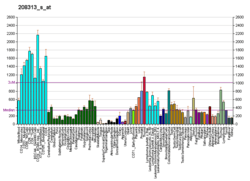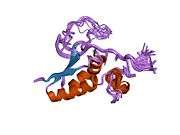SF1 (gene)
Splicing factor 1 also known as zinc finger protein 162 (ZFM162) is a protein that in humans is encoded by the SF1 gene.[3][4][5]
Splicing factor SF1 is involved in the ATP-dependent formation of the spliceosome complex.[6] SF1 gene is necessary to make the bipotential gonad ; but while SF1 levels decline in the genital ridge of XX mouse embryos, the SF1 gene stays on the developing testes. SF 1 (transcription factor) appears to be active in masculining both the Leydig cells and Sertoli cells. In Sertoli cells with the SOX9 protein it elevates the level of AMH transcription. In Leydig cells it activates the gene encoding the enzyme that make testosterone hormone.
Interactions
SF1 (gene) has been shown to interact with Ewing sarcoma breakpoint region 1,[7] U2AF2,[8][9][10] Testis determining factor,[11] and Transcription elongation regulator 1.[12]
References
- GRCh38: Ensembl release 89: ENSG00000168066 - Ensembl, May 2017
- "Human PubMed Reference:". National Center for Biotechnology Information, U.S. National Library of Medicine.
- Toda T, Iida A, Miwa T, Nakamura Y, Imai T (Jul 1994). "Isolation and characterization of a novel gene encoding nuclear protein at a locus (D11S636) tightly linked to multiple endocrine neoplasia type 1 (MEN1)". Hum Mol Genet. 3 (3): 465–70. doi:10.1093/hmg/3.3.465. PMID 7912130.
- Kramer A, Quentin M, Mulhauser F (Jun 1998). "Diverse modes of alternative splicing of human splicing factor SF-1 deduced from the exon-intron structure of the gene". Gene. 211 (1): 29–37. doi:10.1016/S0378-1119(98)00058-4. PMID 9573336.
- "Entrez Gene: SF1 splicing factor 1".
- Rino J, Desterro JM, Pacheco TR, Gadella TW, Carmo-Fonseca M (May 2008). "Splicing factors SF1 and U2AF associate in extraspliceosomal complexes". Mol. Cell. Biol. 28 (9): 3045–57. doi:10.1128/MCB.02015-07. PMC 2293075. PMID 18285458.
- Zhang D, Paley AJ, Childs G (July 1998). "The transcriptional repressor ZFM1 interacts with and modulates the ability of EWS to activate transcription". J. Biol. Chem. 273 (29): 18086–91. doi:10.1074/jbc.273.29.18086. PMID 9660765.
- Rual JF, Venkatesan K, Hao T, Hirozane-Kishikawa T, Dricot A, Li N, Berriz GF, Gibbons FD, Dreze M, Ayivi-Guedehoussou N, Klitgord N, Simon C, Boxem M, Milstein S, Rosenberg J, Goldberg DS, Zhang LV, Wong SL, Franklin G, Li S, Albala JS, Lim J, Fraughton C, Llamosas E, Cevik S, Bex C, Lamesch P, Sikorski RS, Vandenhaute J, Zoghbi HY, Smolyar A, Bosak S, Sequerra R, Doucette-Stamm L, Cusick ME, Hill DE, Roth FP, Vidal M (October 2005). "Towards a proteome-scale map of the human protein-protein interaction network". Nature. 437 (7062): 1173–8. doi:10.1038/nature04209. PMID 16189514.
- Berglund JA, Abovich N, Rosbash M (March 1998). "A cooperative interaction between U2AF65 and mBBP/SF1 facilitates branchpoint region recognition". Genes Dev. 12 (6): 858–67. doi:10.1101/gad.12.6.858. PMC 316625. PMID 9512519.
- Abovich N, Rosbash M (May 1997). "Cross-intron bridging interactions in the yeast commitment complex are conserved in mammals". Cell. 89 (3): 403–12. doi:10.1016/S0092-8674(00)80221-4. PMID 9150140.
- Kashimada K, Koopman P (December 2010). "Sry: the master switch in mammalian sex determination". Development. 137 (23): 3921–30. doi:10.1242/dev.048983. PMID 21062860.
- Goldstrohm AC, Albrecht TR, Suñé C, Bedford MT, Garcia-Blanco MA (November 2001). "The transcription elongation factor CA150 interacts with RNA polymerase II and the pre-mRNA splicing factor SF1". Mol. Cell. Biol. 21 (22): 7617–28. doi:10.1128/MCB.21.22.7617-7628.2001. PMC 99933. PMID 11604498.
Further reading
- Krämer A (1992). "Purification of splicing factor SF1, a heat-stable protein that functions in the assembly of a presplicing complex". Mol. Cell. Biol. 12 (10): 4545–52. doi:10.1128/MCB.12.10.4545. PMC 360381. PMID 1406644.
- Naumovski L, Cleary ML (1996). "The p53-binding protein 53BP2 also interacts with Bc12 and impedes cell cycle progression at G2/M". Mol. Cell. Biol. 16 (7): 3884–92. doi:10.1128/MCB.16.7.3884. PMC 231385. PMID 8668206.
- Arning S, Grüter P, Bilbe G, Krämer A (1996). "Mammalian splicing factor SF1 is encoded by variant cDNAs and binds to RNA". RNA. 2 (8): 794–810. PMC 1369416. PMID 8752089.
- Abovich N, Rosbash M (1997). "Cross-intron bridging interactions in the yeast commitment complex are conserved in mammals". Cell. 89 (3): 403–12. doi:10.1016/S0092-8674(00)80221-4. PMID 9150140.
- Caslini C, Spinelli O, Cazzaniga G, et al. (1997). "Identification of two novel isoforms of the ZNF162 gene: a growing family of signal transduction and activator of RNA proteins". Genomics. 42 (2): 268–77. doi:10.1006/geno.1997.4705. PMID 9192847.
- Zhang D, Childs G (1998). "Human ZFM1 protein is a transcriptional repressor that interacts with the transcription activation domain of stage-specific activator protein". J. Biol. Chem. 273 (12): 6868–77. doi:10.1074/jbc.273.12.6868. PMID 9506990.
- Berglund JA, Abovich N, Rosbash M (1998). "A cooperative interaction between U2AF65 and mBBP/SF1 facilitates branchpoint region recognition". Genes Dev. 12 (6): 858–67. doi:10.1101/gad.12.6.858. PMC 316625. PMID 9512519.
- Zhang D, Paley AJ, Childs G (1998). "The transcriptional repressor ZFM1 interacts with and modulates the ability of EWS to activate transcription". J. Biol. Chem. 273 (29): 18086–91. doi:10.1074/jbc.273.29.18086. PMID 9660765.
- Neubauer G, King A, Rappsilber J, et al. (1998). "Mass spectrometry and EST-database searching allows characterization of the multi-protein spliceosome complex". Nat. Genet. 20 (1): 46–50. doi:10.1038/1700. PMID 9731529.
- Wang X, Bruderer S, Rafi Z, et al. (1999). "Phosphorylation of splicing factor SF1 on Ser20 by cGMP-dependent protein kinase regulates spliceosome assembly". EMBO J. 18 (16): 4549–59. doi:10.1093/emboj/18.16.4549. PMC 1171529. PMID 10449420.
- Lapteva N, Nieda M, Ando Y, et al. (2001). "Expression of renin-angiotensin system genes in immature and mature dendritic cells identified using human cDNA microarray". Biochem. Biophys. Res. Commun. 285 (4): 1059–65. doi:10.1006/bbrc.2001.5215. PMID 11467860.
- Goldstrohm AC, Albrecht TR, Suñé C, et al. (2001). "The transcription elongation factor CA150 interacts with RNA polymerase II and the pre-mRNA splicing factor SF1". Mol. Cell. Biol. 21 (22): 7617–28. doi:10.1128/MCB.21.22.7617-7628.2001. PMC 99933. PMID 11604498.
- Liu Z, Luyten I, Bottomley MJ, et al. (2001). "Structural basis for recognition of the intron branch site RNA by splicing factor 1". Science. 294 (5544): 1098–102. doi:10.1126/science.1064719. PMID 11691992.
- Rappsilber J, Ryder U, Lamond AI, Mann M (2002). "Large-scale proteomic analysis of the human spliceosome". Genome Res. 12 (8): 1231–45. doi:10.1101/gr.473902. PMC 186633. PMID 12176931.
- Strausberg RL, Feingold EA, Grouse LH, et al. (2003). "Generation and initial analysis of more than 15,000 full-length human and mouse cDNA sequences". Proc. Natl. Acad. Sci. U.S.A. 99 (26): 16899–903. doi:10.1073/pnas.242603899. PMC 139241. PMID 12477932.
- Selenko P, Gregorovic G, Sprangers R, et al. (2003). "Structural basis for the molecular recognition between human splicing factors U2AF65 and SF1/mBBP". Mol. Cell. 11 (4): 965–76. doi:10.1016/S1097-2765(03)00115-1. PMID 12718882.
- Beausoleil SA, Jedrychowski M, Schwartz D, et al. (2004). "Large-scale characterization of HeLa cell nuclear phosphoproteins". Proc. Natl. Acad. Sci. U.S.A. 101 (33): 12130–5. doi:10.1073/pnas.0404720101. PMC 514446. PMID 15302935.
- Lin KT, Lu RM, Tarn WY (2004). "The WW domain-containing proteins interact with the early spliceosome and participate in pre-mRNA splicing in vivo". Mol. Cell. Biol. 24 (20): 9176–85. doi:10.1128/MCB.24.20.9176-9185.2004. PMC 517884. PMID 15456888.




